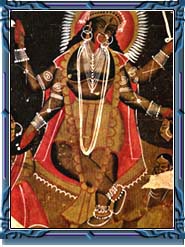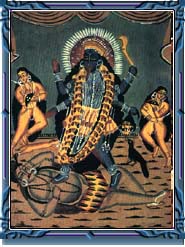|
Festivals of India
Diwali - Festival of Lights
|
|||||
Diwali or Deepaavali means an Array of Lamps (Deep = Lamp, Vali =Array) Lamp, Vali =Array). This is one of the major festivals in the Hindu calendar. It occurs in October/November, and is spread over several days. Dhanteras (Dhanatrayodashi) is the first day or rather the eve of the day on which the festival begins. Narakchaturdashi which is also known as Kalichoudas or Bali Pratipada is the second day. Laxmi Pujan and New year (Padava) normally occur (depending on the Hindu calendar) simultaneously on the third day followed by Gowardhan Puja, and Bhaiya-duj is on the last day. In 2016, Dhanteras is 28th October, Narakchaturdashi on 29th, Diwali and Lakshmi Puja on 30th, Gowardhan Puja on 31st and Bhaiya Duj on 1st November. In 2016, the corresponding dates are 17th October to 21st October with Diwali on 19th October 2017. |
Festivals Of India • Festival Calendar • Ganesh Chaturthi • Nagpanchmi • Ramanavami • Janmastami • MahaShivratri • Passage to India • Features • Tips | ||||
This is a very popular festival in many parts of India. The celebration of Diwali is marked by the lighting of innumerable lamps in every courtyard and the bursting of crackers. Sweetmeats, new clothes etc., are there as in other festivals. The time for rejoicing is mainly early morning and late night. These hours of darkness bordering the waking hours are preferred as lights and crackers are the highlights of the festivities and these need darkness to have their illuminating effect. Hence people rise early and go late to sleep.
Deepavali - A Harvest Festival?
Laxmi Pujan - A Veneration of the Prosperity at the end of an Harvest? For Farmers, a Festival marking the end of one Harvest and the beginning of another, was a festival heralding the beginning of a New Year. The association of the New Year (termed) Padava or Padavo, with Diwali also substantiates the harvest festival theory. The end of one harvest and beginning of another meant the end of one cycle of activity and the beginning of another, as all activities in an agrarian economy must have been linked-up largely with agriculture. Hence it was quite natural to look upon a festival that was observed at the end of one harvest season and the beginning of a new one, as a festival heralding the beginning of a new year. Gudi Padava which is also looked upon as a new year in some parts of India (Maharashtra, Karnataka, Andhra) also occurs at the end of another croppping season (the Rabi season) and co-incides with a harvest. This festival comes around March. And finally both the occasions on which the new year is observed are called Padava. The word Padava is etymologically quite close to the Sanskrit word for crop which is Pradurbhu. Padava might be a corrupted form of the original word for "crop" which was used to term the new year festival. The inference that can be drawn from the above clues is that Diwali as a festival owes its origin to the reaping of a harvest. A Harvest presented a logical occasion for rejoicing and merriment. The Mythology Associated with Deepavali
Dashratha, goes on a Hunt and Wounds a Human Dashratha Grants Three Boons to Kaikeyi An Ivory image of Lord Rama. According to mythology, the celebration of Diwali is closely bound up with one of India's two classic epics the Ramayana. Lord Rama is said to have reigned for a long time during which the people were happy and contented. Ramrajya (the reign of Rama) has come to connote an era of peace and prosperity. The festival of Diwali; we were told is celebrated to commemorate Rama's return from exile. Ramnavami;, another festival is celebrated as the birthday of Lord Rama, sometime in March. Rama Goes in to Exile
Sadly Dashratha agreed and Rama set off for exile with his wife the virtuous Sita and his noble brother Laxman. Soon afterwards, Dashratha died, a heartbroken man. Not only had Dashratha's boons been redeemed but also the curse of Shravana's broken hearted parents, the occurrence of which had escaped Dashratha's memory. Rama Battles Ravana At the end of fourteen years, Rama, Laxman and Sita return to Ayodhya and are given a hero's welcome by the people. Lord Rama is said to have reigned for a long time during which the people were happy and contented. Ramrajya (the reign of Rama) has come to connote an era of peace and prosperity. The festival of Diwali; we were told is celebrated to commemorate Rama's return from exile. Ramnavami;, another festival is celebrated as the birthday of Lord Rama, sometime in March. The Legend of King Bali In memory of this, we are told, that the second day of Diwali (Bali Prati-pada) is celebrated. Prati-pada here translates as "below the opponent's foot" (Prati=opponent, Pada=foot). The Legend of Demon Narakasura But this mythology and ritual is associated with Deepavali only in the Western and Southern India, it is not known in the north and east. Bharatvarsha with its multifarious and colourful legends has many festivals with which different mythologies have become associated. These mythologies differ from region to region and have contributed in making the composite and colourful society of the Hindus. Photo Credit: Sudheer Birodkar |
|||||
Editor: Romola Butalia (c) India Travelogue. All rights reserved. |
|||||
 Worship of the Goddess of Wealth (Laxmi), observance of the New Year and performance of Aarti (a ritual that combines worship and adoration) are a part of the festival On the second day of Deepavaali (Kali Choudas) a ritual that is strongly suggestive of the origin of Deepavaali as an harvest festival is performed. On this day delicacies are prepared from pounded semi-cooked rice (called Poha or Pova). This rice is taken from the fresh harvest available at that time. This custom is prevalent both in rural and urban areas especially in Western India. In rural areas, Diwali signifies only this aspect. As it is Diwali which is celebrated sometime in October/November co-incides with the end of a harvesting season, known as the Kharif season when the fresh crop of rice is available.
Worship of the Goddess of Wealth (Laxmi), observance of the New Year and performance of Aarti (a ritual that combines worship and adoration) are a part of the festival On the second day of Deepavaali (Kali Choudas) a ritual that is strongly suggestive of the origin of Deepavaali as an harvest festival is performed. On this day delicacies are prepared from pounded semi-cooked rice (called Poha or Pova). This rice is taken from the fresh harvest available at that time. This custom is prevalent both in rural and urban areas especially in Western India. In rural areas, Diwali signifies only this aspect. As it is Diwali which is celebrated sometime in October/November co-incides with the end of a harvesting season, known as the Kharif season when the fresh crop of rice is available.

 Mythology has its own reason to offer for the Diwali festival. According to mythology, the celebration of Diwali is closely bound up with one of India's two classic epics the Ramayana. (Mahabharata being the other epic). In brief the Ramayana story is as follows:
Mythology has its own reason to offer for the Diwali festival. According to mythology, the celebration of Diwali is closely bound up with one of India's two classic epics the Ramayana. (Mahabharata being the other epic). In brief the Ramayana story is as follows:
 This second episode also became a thing of the past. After a few more years when Dashratha's eldest son Rama attained manhood, Dashratha felt it was time up for him to renounce worldly pleasures and relinquish his throne in favour of Rama. On hearing this, the people of Ayodhya were jubilant. But all human minds are not identical. Kaikeyi's maid Manthara was jealous of Rama and to prevent his accession to the throne, she went to Kaikeyi and instigated her against Rama by telling her that if Rama became king, she (Kaikeyi)would lose her importance as queen. So she should ask Bharat (Kaikeyi's son) to be installed as king and Rama be exiled for fourteen years. And if Dashratha did not accept these demands, Kaikeyi should ask him to redeem the boons that he had granted her. In the beginning Kaikeyi resisted Manthara's malicious advice, but as temptation got the better of sagacity, she relented and Dashratha had to redeem the three boons by:
This second episode also became a thing of the past. After a few more years when Dashratha's eldest son Rama attained manhood, Dashratha felt it was time up for him to renounce worldly pleasures and relinquish his throne in favour of Rama. On hearing this, the people of Ayodhya were jubilant. But all human minds are not identical. Kaikeyi's maid Manthara was jealous of Rama and to prevent his accession to the throne, she went to Kaikeyi and instigated her against Rama by telling her that if Rama became king, she (Kaikeyi)would lose her importance as queen. So she should ask Bharat (Kaikeyi's son) to be installed as king and Rama be exiled for fourteen years. And if Dashratha did not accept these demands, Kaikeyi should ask him to redeem the boons that he had granted her. In the beginning Kaikeyi resisted Manthara's malicious advice, but as temptation got the better of sagacity, she relented and Dashratha had to redeem the three boons by: